Surviving B-36 Peacemaker Bombers
More About the B-36: Design, Production, Deployment & Scrapping B-36 - National Museum of the U.S. Force B-36 - Pima Air & Space Museum B-36 - Strategic Air Command & Aerospace Museum |
The Convair B-36 Peacemaker was one of the largest airplanes ever built, and was a key element in maintaining peace during the Cold War with Russia during the 1950s. Originally conceived in 1941 as an intercontinental bomber, it came into production in the late 1940s.
The Army Air Corps' specifications for this very long-range nuclear bomber required it to have a top speed of 450-mph, a service ceiling of 45,000 feet, carry a 10,000 pound bomb load, and fly non-stop for 12,000 miles.
This would enable the bomber to strike targets in Europe from air bases in the United States, and return to their home base. Bids were issued to the Boeing Aircraft Company and to Consolidated Aircraft, the ultimate winner of the B-36 contract.
Convair won the contract, and ultimately built a total of 382 B-36 Peacemakers, plus one XC-99 transport and two YB-60 jet bombers.
A B-36 in Flight Status?
Some people want to know ... are there any B-36 bombers still flying today? Only four Peacemakers survive today, and those are on static display in museums, as explained below in this article. There are no B-36s in airworthy status.
Read about the restoration of a B-36 to airworthy status.
B-36 Development, Testing and Production
The XB-36 (S/N 42-13570) made its maiden flight on August 8, 1946. The second prototype was designated the YB-36 (S/N 42-13571), and flew for the first time on December 4, 1947. The first B-36A (S/N 44-92005) was accepted in May of 1948.
Much of the B-36's external skin was made of magnesium, which had a dull color, in contrast to the shiny aluminum used to cover the fore and aft pressurized compartments. During production of the Peacemaker, Convair and the Air Force evolved the plane to the B-36D, B-36F, and B-36H models.
A major change to the original, basic B-36 design was the addition of jet engines. Beginning with the B-36D, the Peacemaker added four General Electric J47-GE-19 jet engines, mounted in pods like those used in the Boeing B-47. Ultimately, the Air Force had all earlier B-36 units reconfigured with the jet engines.
These giant bombers were built in Fort Worth, Texas by the Consolidated Vultee Aircraft Corporation (later known as Convair), located across the runway from Carswell Air Force Base.
Convair's Attempt to Build An All-Jet B-36, the YB-60
Convair YB-60 and B-36 parked side by side on the apron |
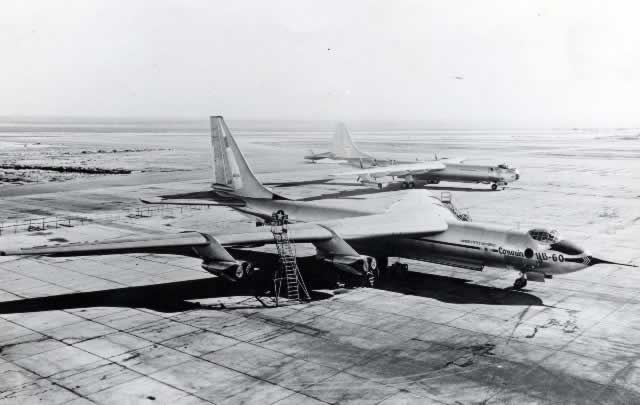 |
As the advent of jet aircraft began to emerge in the late 1940s and early 1950s, Convair started design on a swept-winged version of the B-36 with all-jet propulsion, known as the Convair YB-60. It also designed and built a prototype large-scale transport plane, the Convair XC-99.
In March 1951, the US Air Force authorized Convair to convert two B-36Fs to B-36Gs. Since the jet aircraft was so different from production B-36 models, the designation was later changed to YB-60.
The eight-engine YB-60 shared 72% of its parts with the B-36. The fuselages of the two aircraft were nearly identical, although the YB-60 had a longer, pointed nose with a needle-like instrument probe, instead of the B-36's rounded nose.
End of the Line and Scrapping of the B-36
B-36 Peacemakers in storage at Davis-Monthan Air Force Base in Tucson in 1958 RB-36H Serial Number 51-13723 of the 72nd Bombardment (Heavy) Wing is in the foreground |
 |
By 1953, the Air Force had made the decision to procure the Boeing B-52 Stratofortress and not the YB-60 as its next long-range heavy bomber.
The end of service life for the B-36 had begun. In February of 1956, the first B-36 aircraft arrived at Davis-Monthan Air Force Base in Tucson, Arizona for storage and ultimate scrapping.
Mar-Pak Corporation was the agent of the U.S. Government assigned to the B-36 dismantling program.
By late 1958 only 22 B-36Js were left on active duty, at Biggs AFB in Texas. On February 12, 1959, the last operational flight of the B-36 took place, as 52-2827 flew from Biggs AFB to Fort Worth. It remained on display for several years there, until its move to the Pima Air and Space Museum in Tucson where it is currently located.
The last Peacemaker to be scapped was S/N 49-2712, on July 25, 1961.
Aerial view of Convair B-36 Peacemakers at Davis-Monthan AFB in Tucson, Arizona, engines removed and awaiting scrapping |
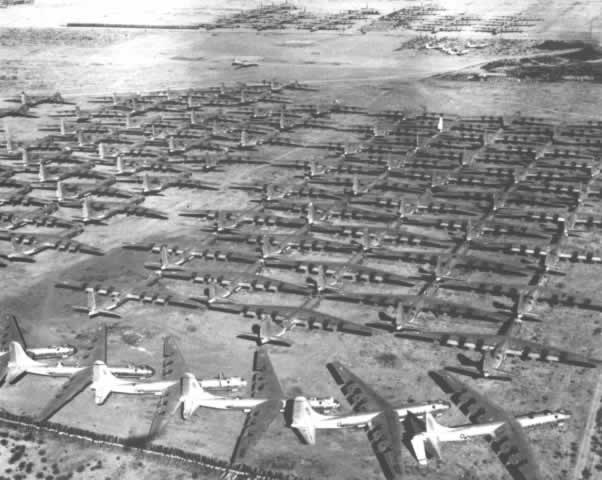 |
Mar-Pak Corporation ad for the sale of surplus B-36 components at its Davis-Monthan facility in Tucson, AZ |
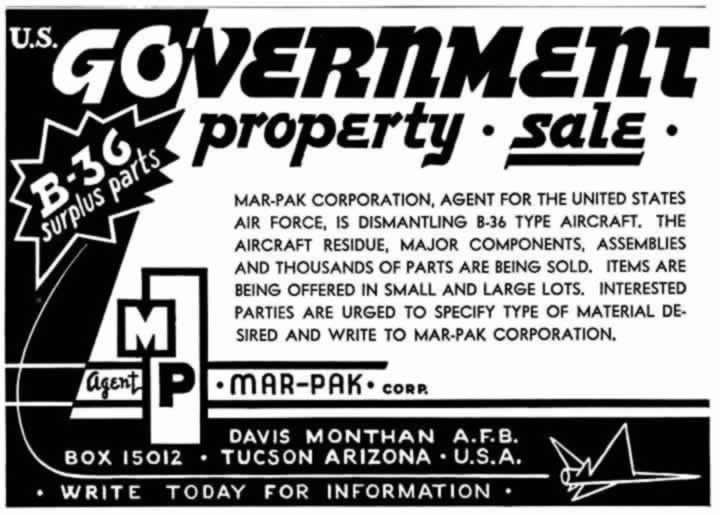 |
Aerial view of nine B-36 Peacemakers in various stages of being scrapped by Mar-Pak at Davis-Monthan AFB |
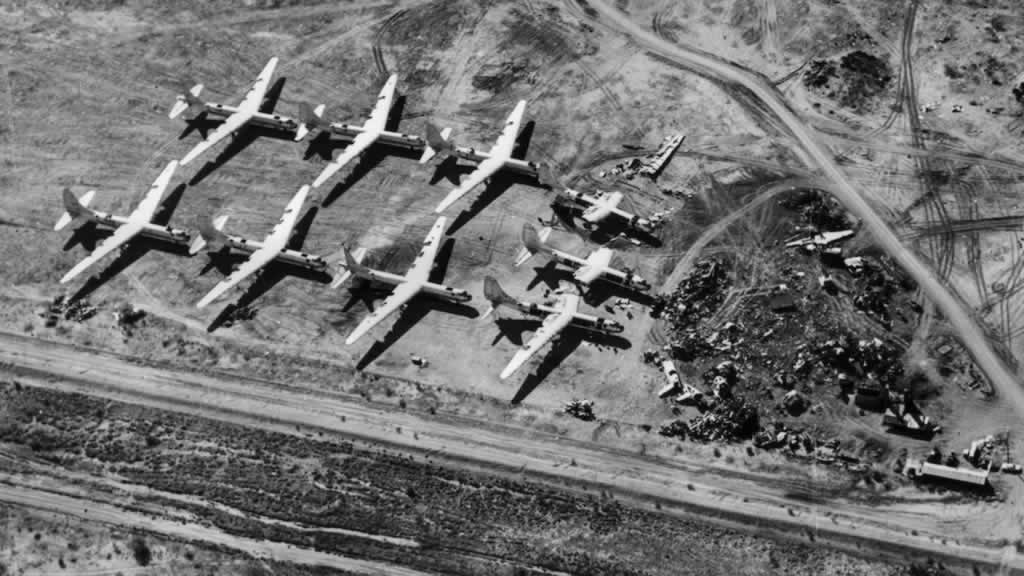 |
Will There Ever Be an Airworthy B-36?
Many aviation historians and Air Force enthusiasts want to know if there will ever be another airworthy B-36.
This is a reasonable question, given the successful projects to restore two B-29 Superfortresses to flight status, i.e., FiFi and Doc.
Several other vintage aircraft models include airworthy restorations, such as the B-17 Flying Fortress, B-24 Liberator, B-25 Mitchell, P-51 Mustang, C-47, F-100 Super Sabre and others. Why not have an airworthy B-36 in flying status?
Read about restoration of a B-36 to airworthy status.
The B-36 Survivors
Only four complete Convair B-36 Peacemaker air frames have survived of the 383 that were built. We have had the good fortune of viewing and photographing all four.
The B-36 survivors are listed below ... click the links for additional information and photographs of the airplane at each facility.
Facility |
Location |
Model |
Serial No. |
| National Museum of the U.S. Air Force | Wright-Patterson Air Force Base Dayton, Ohio |
B-36J-1-CF | 52-2220 |
| Pima Air and Space Museum | Adjacent to Davis-Monthan Air Force Base Tucson, Arizona |
B-36J-10-CF | 52-2827 |
| Strategic Air Command and Aerospace Museum | Ashland, Nebraska | B-36J-1-CF | 52-2217 |
| Castle Air Museum | Atwater, California | RB-36H-30-CF | 51-13730 |
Parts of a fifth B-36, S/N 42-13571, on display at the Air Force Museum in Dayton until December of 1957, are located in Newbury, Ohio, in the Walter Soplata Aviation Collection. It was originally a YB-36, the first Peacemaker with the domed cockpit, and later converted to a RB-36E.
The shield of the Strategic Air Command, painted on the RB-36H Peacemaker at the Castle Air Museum |
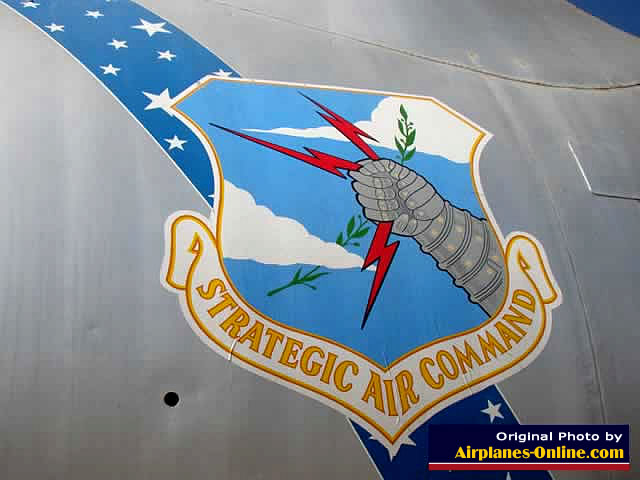 |
Convair B-36J-10-CF Peacemaker, S/N 52-2827, the last production B-36J, now restored and on display at the Pima Air & Space Museum in Tucson, Arizona |
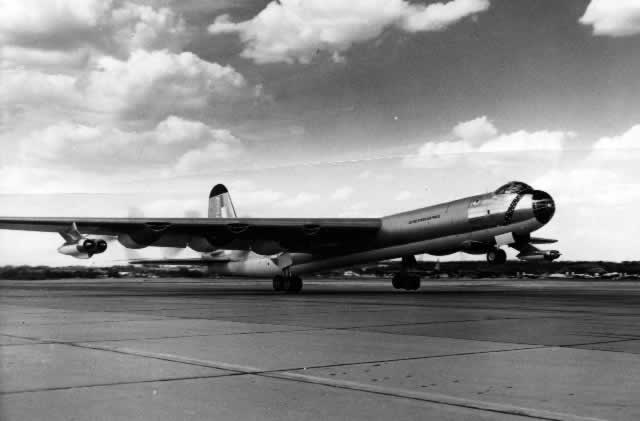 |
Convair B-36J Peacemaker S/N 52-2827 at the Pima Air & Space Museum in Tucson, Arizona view more photos of this B-36 |
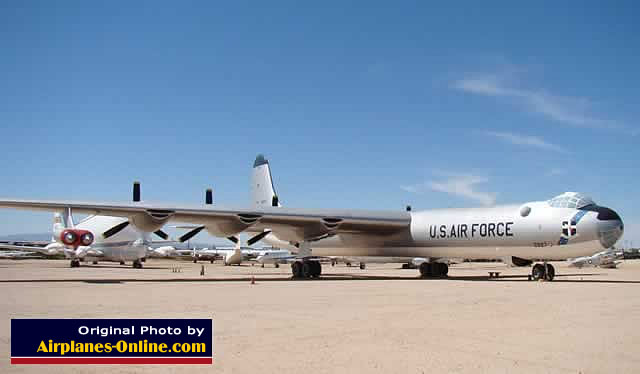 |
B-36 Peacemaker 52-2220 on display at the Museum of the United States Air Force, Wright-Patterson AFB, Dayton, Ohio view more photos of this B-36 |
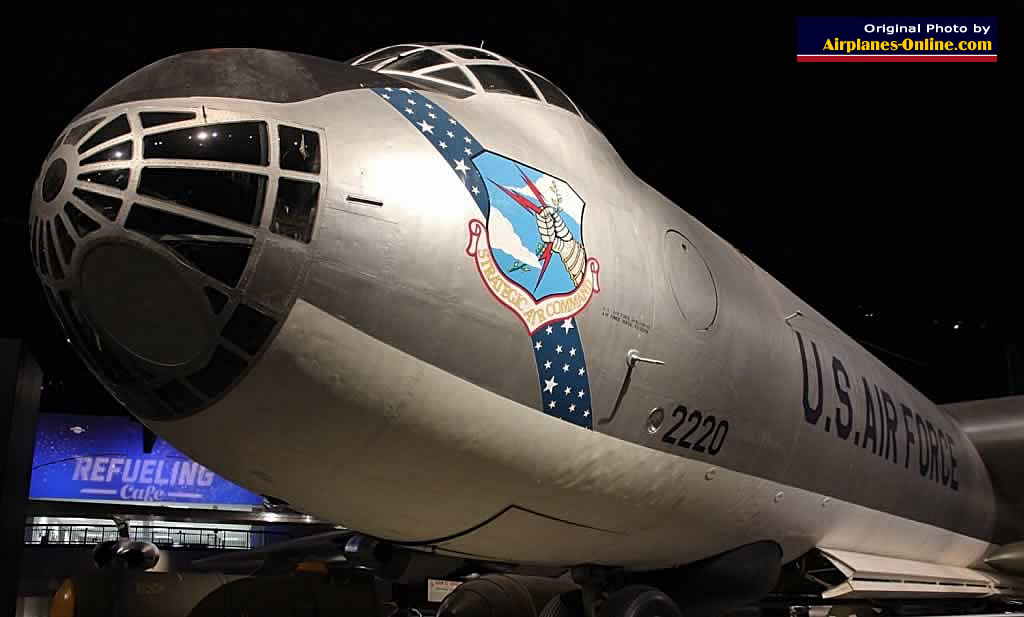 |
One of the four surviving Peacemakers ... RB-36H Serial No. 51-13730, at the Castle Air Museum in Atwater, California view more photos of this B-36 |
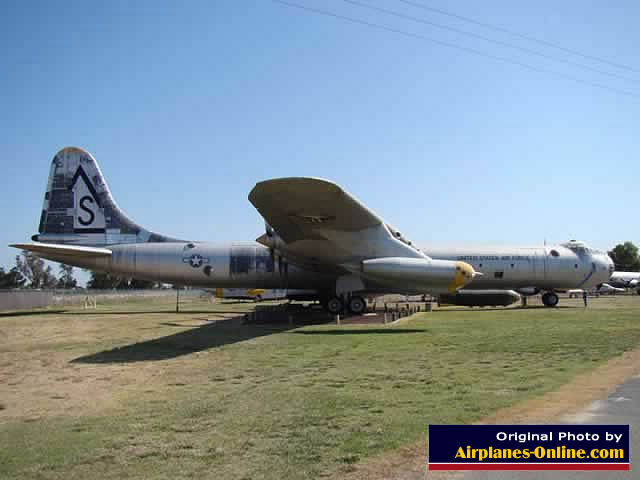 |
Convair B-36J Peacemaker S/N 52-2217 at the Strategic Air & Space Museum in Nebraska view more photos of this B-36 |
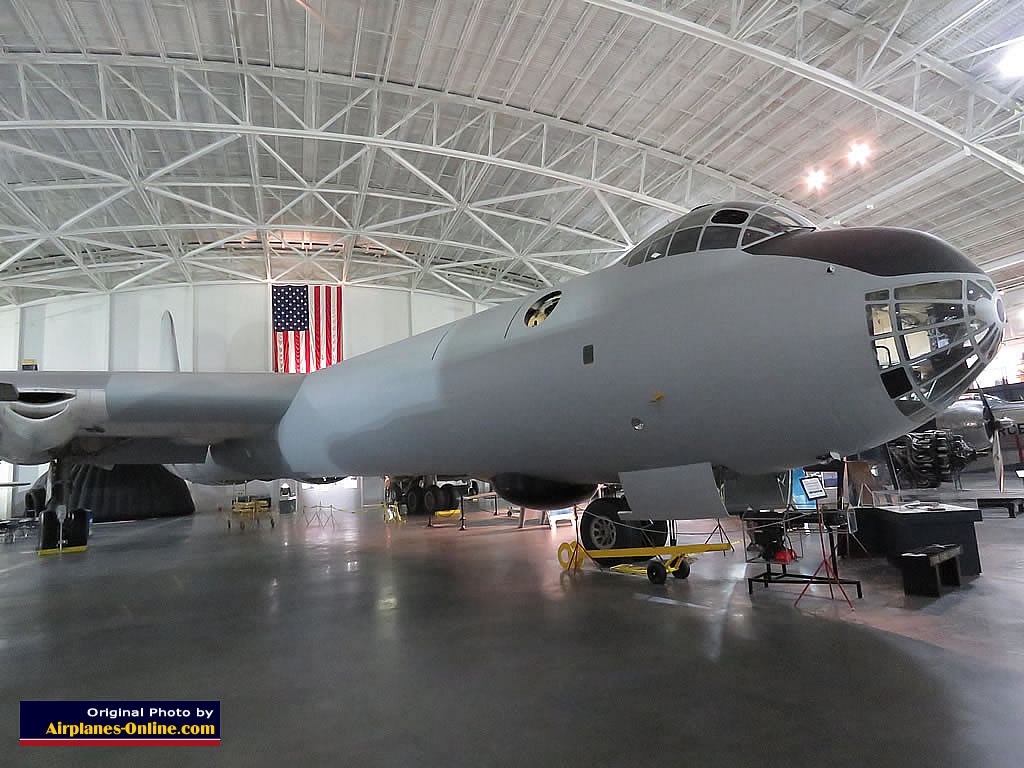 |

